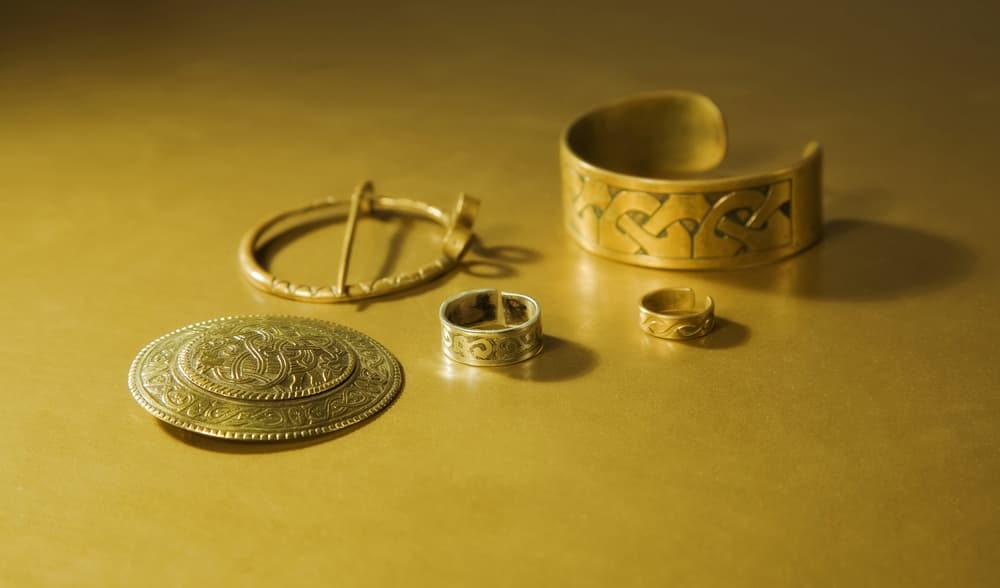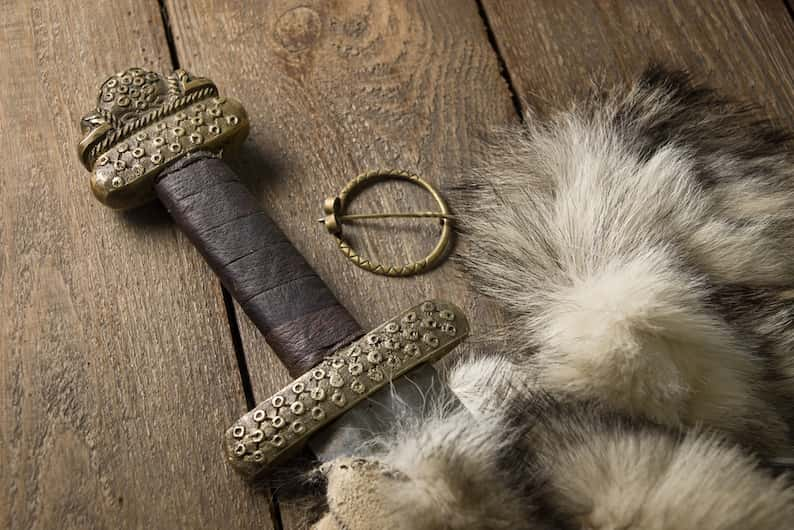Given worldwide attention by the artist known as Bjork having one on her left arm, the Vegvisir is a complex and beautiful symbol.
Viking runes and symbology evoke a sense of spiritual wonder and raw power from the ancient world, so it certainly looks like something that a Viking could create.
But what is the Vegvisir’s meaning and is it a Viking symbol?

Table of Contents
What is the Vegvisir?
The Vegvisir is one of many magical staves that originate from the unique mixture of Norse paganism and Christianity that emerged in Iceland after the Viking Age. The text included with the stave suggests that it protects those who would get lost due to bad weather and other unforeseen events.
Runes have magical power in Norse mythology. Odin, the wise and mighty leader of the Viking gods, hung himself from Yggdrasil the World-Tree for nine days in order to unlock their secrets, and he passed on a portion of that wisdom to mankind.

Over time, both the runes and their usage changed with the times. Magical staves came about in Iceland as one such adaptation. While not entirely formed from runes or intended to be legible, many of the staves are clearly derived from runes.
In particular, the triple forks are seen across many staves and many variations of the Futhark, the runic alphabet. In the Elder Futhark, the shape stood for the rune algiz.
The Younger Futhark was used closer to the first known instance of the Vegvisir. In that version of the runic alphabet, the upright version of the triple fork is the rune Madr, or “man”, and the upside-down version is the rune Yr, or “yew”.
What’s the meaning of Vegvisir?
Vegvísir is a compound Icelandic word formed from veg, which translates to a road or a path, and visir, which translates to a sign or indication of a way forward. Common translations include “signpost” and “wayfinder”, though similar phrases might be used.
Is Vegvisir actually Viking?
The Vegvisir is a relatively modern symbol with no known usage before the 17th century. Since Viking culture only continued until the 12th century, it doesn’t come directly from the Vikings. Instead, it is a product of Viking descendants, having been further emphasized by pop culture.
Where does Vegvisir come from?
The Vegvisir origin story begins in Iceland, a country that was settled and populated largely by Norwegian Vikings, their families, and their captives. The first recorded image and explanation of the stave is in the Huld Manuscript, a text created in the 17th century.
Iceland was mostly uninhabited when the Vikings arrived, so they were the dominant culture in the area. Elements of cultures from Britain and Ireland also appear due to their assimilation with Norwegian Vikings.

Is the Vegvisir a pagan symbol?
The Vegvisir comes from later works that were strongly influenced by Norse paganism. Magical staves and other pagan practices continued to exist, but the people who utilized it would call themselves Christian, even if it is not itself a Christian symbol.
Even when new religions enter an area, old traditions can carry forward. With its relative isolation and little attention from the church, the Icelandic people were fairly free to merge their faiths together.
Christians outside of Iceland would likely call it a pagan symbol if you asked them, but the locals’ answers could be more complex.
You may also be interested in: Valkyrie Symbol in Norse Mythology: Its Meaning and More
Is the Vegvisir connected to the Nordics?
The Vegvisir does have clear links to the Nordic region, having likely been created by descendants of the Vikings in Iceland, who primarily came from Norway. However, since it was developed after the Viking Age, the symbol isn’t as connected to the Swedish and Danish Vikings.
Although it isn’t known to have a direct connection to the original Vikings, to this day, the culture that survived in Iceland has some of the strongest elements of all Nordic countries and Viking settlements.
That link is evident in the design and makes it easy to assume that the Vegvisir has earlier origins. On a closer look, the complexity is greater than anything seen in most Viking Age symbology, including the Valknut.

What do the runes say around Vegvisir?
Runes included around a Vegvisir are additions that are not part of the original magic stave, given that the original runes long predate the Vegvisir symbol. Since there’s no standard runic inscription, you’ll have to ask the artist or owner of that specific Vegvisir interpretation.
While the Norse runes do make it seem like the Vegvisir’s meaning dates from the same era as the runes, this actually isn’t the case.
What do the charms on the Vegvisir do?
The exact meanings of all the charms on the Vegvisir have not been established, but they are most likely a variety of protective and guiding charms meant to counteract the effects of bad weather, which could be low visibility or difficult terrain.
How do you say Vegvisir?
Vegvisir pronunciation starts by breaking it up into three sections as “Veg-vi-sir”. The “g” is a hard “g”, which is pronounced the same way as the “g” in “ago”. The “i” has a long “e” sound in both instances, as in the word “tree”.
If you’re still not sure, a quick search can help with audible examples.
What is the difference between the Helm of Awe and Vegvisir?
Compared to the Vegvisir stave, Ægishjálmur, the Helm of Awe, shares an eight-spoke shape, but it has much less variety in charms at the end of the eight staves. They also had far different magical purposes, with the Helm of Awe striking fear into enemies instead of serving as a helpful guide.
Since you can find out about the Vegvisir above, here is a look at the Helm of Awe to see the differences. The design itself can’t be traced back to the time of the Vikings, but the meaning of the symbol’s name does.
“The fear-helm I wore | to afright mankind,
While guarding my gold I lay;
Mightier seemed I | than any man,
For a fiercer never I found.”
Fafnir speaking to Sigurth in the Poetic Edda’s Fafnismol
“The Helm of Awe” also translates as the “Helm of Terror” or the “fear-helm”. Given the importance of Viking mythology in Iceland, the origin of the symbol, it is unlikely that the connection is unintentional. Displaying the symbol on one’s forehead could potentially win battles, presumably by invoking the same sense of fear or terror.

So, where the Vegvisir uses a large variety of charms to overcome any obstacle to find a way home, the Helm of Awe is a stave that is meant to overcome any foe. Sharing the same shape shows how the spokes of the Vegvisir are not directly related to the compass.
What is a Vegvisir tattoo?
A Vegvisir holds no special meaning in tattoo form by its own instructions, but it could be a way for a person to believe that the magical protection of the symbol will always be with them. It can also be a way for the tattooed person to honor the Vikings in some form.
Mentioned way back at the start, the artist known as Bjork has a Vegvisir as a tattoo on her arm. According to an interview with Rolling Stone in 1995, she got the tattoo to always guide her home.
Similar reasoning is likely why others get the symbol as a tattoo, but the only way to be certain is to ask that individual. You may, however, want to gently correct them if they say that it’s a traditional Viking tattoo given that, as covered above, the symbol didn’t exist during the Viking era.
Vegvisir in jewelry and fashion
Wearing a Vegvisir is a great way to keep one nearby, since there are plenty of paths in life that could benefit from guidance. It’s not as permanent as a tattoo, and it’s possible to produce accessories on a larger scale and send them around the world.

Thanks to a resurging interest in Viking culture, including those amongst the wonderful readers of this article, more artisans have started producing works that include symbols like the Vegvisir – even if it’s not quite as ancient as some other symbols.
Related: Viking Piercings: The Historical Truth
What is a Vegvisir ring?`
Because of its square or circular shape, the Vegvisir works well either in its traditional shape or placed around the outside of a ring. Take caution when purchasing a ring that modifies the shape of the Vegvisir too much, as the positioning of the runes may change their meaning.
The power inherent in runes and staves has spurred many warnings about their misuse by those who don’t understand them. Adding a ring of runes around a Vegvisir seems safe, as long as the core symbol remains intact.
I would personally hesitate to use one that changes the arrangement of the Vegvisir itself, but it’s possible that I’m overly cautious when working with powers granted by old gods, even if I don’t necessarily believe in them.
